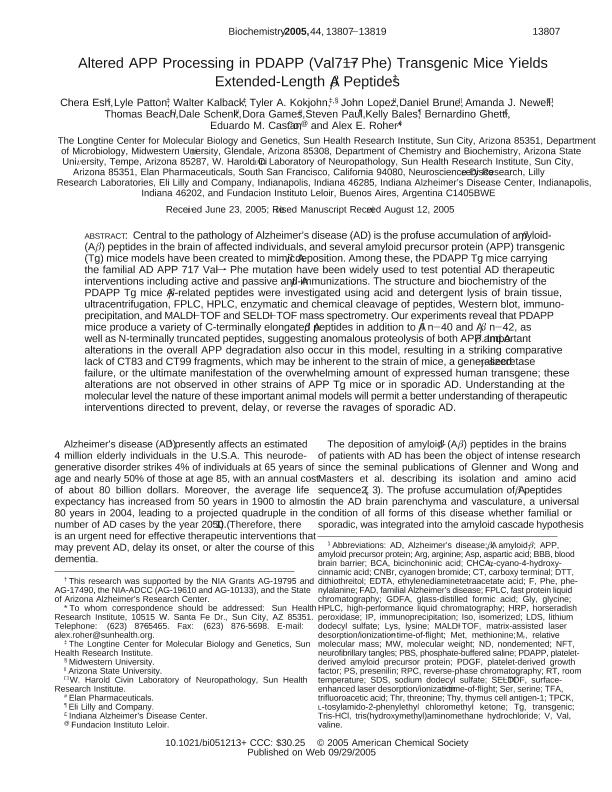Mostrar el registro sencillo del ítem
dc.contributor.author
Esh, Chera
dc.contributor.author
Patton, Lyle
dc.contributor.author
Kalback, Walter
dc.contributor.author
Kokjohn, Tyler A.
dc.contributor.author
Lopez, John
dc.contributor.author
Brune, Daniel
dc.contributor.author
Newell, Amanda J.
dc.contributor.author
Beach, Thomas
dc.contributor.author
Schenk, Dale
dc.contributor.author
Games, Dora
dc.contributor.author
Paul, Steven
dc.contributor.author
Bales, Kelly
dc.contributor.author
Ghetti, Bernardino
dc.contributor.author
Castaño, Eduardo Miguel

dc.contributor.author
Roher, Alex E.
dc.date.available
2018-05-08T19:03:23Z
dc.date.issued
2005-10
dc.identifier.citation
Esh, Chera; Patton, Lyle; Kalback, Walter; Kokjohn, Tyler A.; Lopez, John; et al.; Altered APP Processing in PDAPP (Val717 → Phe) Transgenic Mice Yields Extended-Length Aβ Peptides.; American Chemical Society; Biochemistry; 44; 42; 10-2005; 13807-13819
dc.identifier.issn
0006-2960
dc.identifier.uri
http://hdl.handle.net/11336/44474
dc.description.abstract
Central to the pathology of Alzheimer's disease (AD) is the profuse accumulation of amyloid-beta (Abeta) peptides in the brain of affected individuals, and several amyloid precursor protein (APP) transgenic (Tg) mice models have been created to mimic Abeta deposition. Among these, the PDAPP Tg mice carrying the familial AD APP 717 Val --> Phe mutation have been widely used to test potential AD therapeutic interventions including active and passive anti-Abeta immunizations. The structure and biochemistry of the PDAPP Tg mice Abeta-related peptides were investigated using acid and detergent lysis of brain tissue, ultracentrifugation, FPLC, HPLC, enzymatic and chemical cleavage of peptides, Western blot, immunoprecipitation, and MALDI-TOF and SELDI-TOF mass spectrometry. Our experiments reveal that PDAPP mice produce a variety of C-terminally elongated Abeta peptides in addition to Abeta n-40 and Abeta n-42, as well as N-terminally truncated peptides, suggesting anomalous proteolysis of both APP and Abeta. Important alterations in the overall APP degradation also occur in this model, resulting in a striking comparative lack of CT83 and CT99 fragments, which may be inherent to the strain of mice, a generalized gamma-secretase failure, or the ultimate manifestation of the overwhelming amount of expressed human transgene; these alterations are not observed in other strains of APP Tg mice or in sporadic AD. Understanding at the molecular level the nature of these important animal models will permit a better understanding of therapeutic interventions directed to prevent, delay, or reverse the ravages of sporadic AD.
dc.format
application/pdf
dc.language.iso
eng
dc.publisher
American Chemical Society

dc.rights
info:eu-repo/semantics/openAccess
dc.rights.uri
https://creativecommons.org/licenses/by-nc-sa/2.5/ar/
dc.subject
Alzheimer'S Disease
dc.subject
Animal Models
dc.subject
Proteolytic Processing
dc.subject.classification
Otras Ciencias Biológicas

dc.subject.classification
Ciencias Biológicas

dc.subject.classification
CIENCIAS NATURALES Y EXACTAS

dc.title
Altered APP Processing in PDAPP (Val717 → Phe) Transgenic Mice Yields Extended-Length Aβ Peptides.
dc.type
info:eu-repo/semantics/article
dc.type
info:ar-repo/semantics/artículo
dc.type
info:eu-repo/semantics/publishedVersion
dc.date.updated
2018-04-05T19:22:48Z
dc.identifier.eissn
1520-4995
dc.journal.volume
44
dc.journal.number
42
dc.journal.pagination
13807-13819
dc.journal.pais
Estados Unidos

dc.journal.ciudad
Washington
dc.description.fil
Fil: Esh, Chera. Sun Health Research Institute; Estados Unidos
dc.description.fil
Fil: Patton, Lyle. Sun Health Research Institute; Estados Unidos
dc.description.fil
Fil: Kalback, Walter. Sun Health Research Institute; Estados Unidos
dc.description.fil
Fil: Kokjohn, Tyler A.. Sun Health Research Institute; Estados Unidos
dc.description.fil
Fil: Lopez, John. Arizona State University; Estados Unidos
dc.description.fil
Fil: Brune, Daniel. Arizona State University; Estados Unidos
dc.description.fil
Fil: Newell, Amanda J.. Sun Health Research Institute; Estados Unidos
dc.description.fil
Fil: Beach, Thomas. Sun Health Research Institute; Estados Unidos
dc.description.fil
Fil: Schenk, Dale. Elan Pharmaceuticals; Irlanda
dc.description.fil
Fil: Games, Dora. Elan Pharmaceuticals; Irlanda
dc.description.fil
Fil: Paul, Steven. Eli Lilly and Company; Estados Unidos
dc.description.fil
Fil: Bales, Kelly. Eli Lilly and Company; Estados Unidos
dc.description.fil
Fil: Ghetti, Bernardino. Indiana Alzheimer’s Disease Center; Estados Unidos
dc.description.fil
Fil: Castaño, Eduardo Miguel. Consejo Nacional de Investigaciones Científicas y Técnicas. Oficina de Coordinación Administrativa Parque Centenario. Instituto de Investigaciones Bioquímicas de Buenos Aires. Fundación Instituto Leloir. Instituto de Investigaciones Bioquímicas de Buenos Aires; Argentina
dc.description.fil
Fil: Roher, Alex E.. Sun Health Research Institute; Estados Unidos
dc.journal.title
Biochemistry

dc.relation.alternativeid
info:eu-repo/semantics/altIdentifier/url/https://pubs.acs.org/doi/abs/10.1021/bi051213+
dc.relation.alternativeid
info:eu-repo/semantics/altIdentifier/doi/http://dx.doi.org/10.1021/bi051213%2B
Archivos asociados
